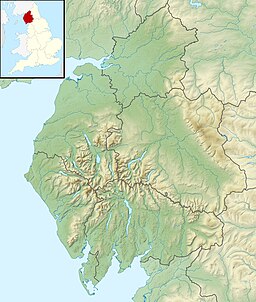| Seathwaite Tarn | |
|---|---|
 | |
| Location | Lake District |
| Coordinates | 54°22′44.66″N 3°9′17.83″W / 54.3790722°N 3.1549528°W |
| Type | reservoir |
| Primary inflows | Tarn Head Beck, Near Gill, Far Gill, Bleaberry Gill |
| Primary outflows | Tarn Beck |
| Basin countries | United Kingdom |
| Surface area | 66 acres (267,093 m2)[1] |
| Max. depth | 80 feet (24 m) |
| Water volume | 2,945,000 m3 (104,000,000 cu ft) |
| Surface elevation | 1,200 feet (366 m)[1] |
| References | [1] |
| Seathwaite Tarn dam | |
|---|---|
 | |
| Dam and spillways | |
| Height | 9 m (30 ft) |
| Length | 138 m (453 ft) |
Seathwaite Tarn is a reservoir in the Furness Fells within the English Lake District. It is located to the south of Grey Friar and to the west of Brim Fell (on the ridge between The Old Man of Coniston and Swirl How) and north east of the village of Seathwaite on the east of the Duddon Valley.
In order to create a source of drinking water the existing tarn was considerably enlarged with a dam in 1904. During the dam construction some of the navvies rioted damaging buildings in the village, several rioters were shot, one dying the next day.[2]

The dam is almost 400 yards (366 m) long and is concrete cored with slate buttresses, the resulting depth of the tarn being around 80 feet (24 m). Water is not abstracted directly from the tarn, but flows some distance downriver to an off-take weir.
On the slopes of Brim Fell, above the head of the reservoir, are the remains of Seathwaite Tarn Mine. This was worked for copper in the mid 19th century, and also appears as a location in the novel The Plague Dogs by Richard Adams. Rocks in the area were the first confirmed occurrence of wittichenite in the British Isles.[3]
Bronze Age ring cairns were found close to Seathwaite Tarn in 2003, these were excavated in 2003 and 2007.[4]
Seathwaite Tarn has suffered from acidification. An experiment in 1992–1993 to reduce the acidification by using a phosphorus-based fertiliser increased the pH from 5.1 to 5.6 and changed the levels of the different species of the rotifer assemblage significantly.[5]
- ^ a b c "Seathwaite Tarn". The Lake District Wiki. Archived from the original on 20 May 2009. Retrieved 3 August 2009.[unreliable source?][dead link]
- ^ C. J. STANLEY; A. J. CRIDDLE (March 1979). "Mineralization at Seathwaite Tarn, near Coniston, English Lake District: The first occurrence of wittichenite in Great Britain" (PDF). Mineralogical Magazine. 43 (325): 103–107. Bibcode:1979MinM...43..103S. CiteSeerX 10.1.1.601.5508. doi:10.1180/minmag.1979.043.325.06. S2CID 53388650. Archived from the original (PDF) on 27 May 2016. Retrieved 3 August 2009.
- ^ "Seathwaite Tarn excavation". Lake District National ark website. National Parks. 2007. Archived from the original on 4 July 2009. Retrieved 3 August 2009.
- ^ May, Linda (November 1995). "The effect of lake fertilisation on the rotifers of Seathwaite Tarn, an acidified lake in the English Lake District". Hydrobiologia. 313–314 (1): 333–340. doi:10.1007/BF00025966. S2CID 1488592.
